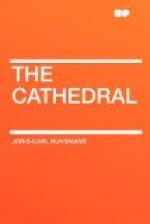“Symbols, then, have a divine origin; it may be added that from the human point of view this form of teaching answers to one of the least disputable cravings of the human mind. Man feels a certain enjoyment in giving proof of his intelligence, in guessing the riddle thus presented to him, and likewise in preserving the hidden truth summed up in a visible formula, a perdurable form. Saint Augustine expressly says: ’Anything that is set forth in an allegory is certainly more emphatic, more pleasing, more impressive, than when it is formulated in technical words.’”
“That is Mallarme’s idea too,” thought Durtal, “and this coincidence in the views of the saint and the poet, on grounds at once analogous and different, is whimsical, to say the least.”
“Thus in all ages,” the Abbe went on, “men have taken inanimate objects, or animals and plants, to typify the soul and its attributes, its joys and sorrows, its virtues and its vices; thought has been materialized to fix it more securely in the memory, to make it less fugitive, more near to us, more real, almost tangible.
“Hence the emblems of cruelty and craft, of courtesy and charity, embodied by certain creatures, personified by certain plants; hence the spiritual meanings attributed to precious stones, and to colours. And it may be added that in times of persecution, in the early Christian times, this hidden language enabled the initiated to hold communication, to give each other some token of kinship, some password which the enemy could not interpret. Thus, in the paintings discovered in catacombs, the Lamb, the Pelican, the Lion, the Shepherd, all meant the Son; the Fish Ichthys, of which the characters express the Greek formula: ’Jesus, Son of God, Saviour,’ figures, in a secondary sense, the believer, the rescued soul, fished out from the sea of Paganism; the Redeemer having told two of His Apostles that they should be fishers of men.
“And of course the period when human beings lived in closest intercourse with God—the Middle Ages—was certain to follow the revealed tradition of Christ, and express itself in symbolical language, especially in speaking of that Spirit, that essence, that incomprehensible and nameless Being who to us is God. At the same time it had at its command a practical means of making itself understood. It wrote a book, as it were, intelligible to the humblest, superseding the text by images, and so instructing the ignorant. This indeed was the idea put into words by the Synod of Arras in 1025: ’That which the illiterate cannot apprehend from writing shall be shown to them in pictures.’
“The Middle Ages, in short, translated the Bible and Theology, the lives of the Saints, the apocryphal and legendary Gospels into carved or painted images, bringing them within reach of all, and epitomizing them in figures which remained as the permanent marrow, the concentrated extract of all its teaching.”




